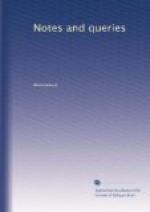“A Letter to a Member of Parliament showing that a restraint on the Press is inconsistent with the Protestant Religion and dangerous to the Liberties of the Nation.” Printed 1697, and reprinted in Cobbett’s Parliamentary History, v. App. p. cxxx.
C.H. COOPER.
Cambridge, October 29. 1850.
* * * * *
REMAINS OF JAMES II.
(Vol. ii., pp. 243. 281.)
To the information which has recently been furnished in your pages respecting the remains of James II., it may be not uninteresting to add the inscription which is on his monument in the church of St. Germain-en-Laye, and which I copied, on occasion of my last visit to France.
The body of the king, or a considerable portion of it, which had remained unburied, was, I believe, interred at St. Germain soon after the termination of the war in 1814; but it being necessary to rebuild the church, the remains were exhumed and re-interred in 1824. Vicissitudes as strange in death as in life seem to have attended this unhappy king.
The following is the inscription now on his monument in the parish church of St. Germain:
“REGIO CINERI PIETAS REGIA.
“Ferale quisquis hoc monumentum
suspicis
Rerum humanarum vices meditare
Magnus in prosperis in adversis major
Jacobus 2. Anglorum Rex.
Insignes aerumnas dolendaque nimium fata
Pio placidoque obitu exsolvit
in hac urbe
Die 16. Septemb. anni 1701.
Et nobiliores quaedam corporis ejus partes
Hic reconditae asservantur.”
* * * * *
Qui prius augusta gestabat fronte coronam
Exigua nunc pulvereus requiescit in urna
Quid solium—quid et alta juvant! terit omnia lethum,
Verum laus fidei ac morum haud peritura manebit
Tu quoque summe Deus regem quem regius hospes
Infaustum excepit tecum regnare jubebis.”
But a different inscription formerly was placed over the king’s remains in this church, which has now disappeared; at all events, I could not discover it; and I suppose that the foregoing was preferred and substituted for that, a copy of which I subjoin:




